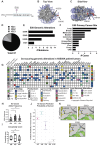Histone H3E50K remodels chromatin to confer oncogenic activity and support an EMT phenotype
- PMID: 39901931
- PMCID: PMC11788928
- DOI: 10.1093/narcan/zcaf002
Histone H3E50K remodels chromatin to confer oncogenic activity and support an EMT phenotype
Abstract
Sequencing of human patient tumors has identified recurrent missense mutations in genes encoding core histones. We report that mutations that convert histone H3 amino acid 50 from a glutamate to a lysine (H3E50K) support an oncogenic phenotype. Expression of H3E50K is sufficient to transform human cells as evidenced by an increase in cell migration and invasion, and an increase in proliferation and clonogenicity. H3E50K also increases the invasive phenotype in the context of co-occurring BRAF mutations, which are present in patient tumors characterized by H3E50K. H3E50 lies on the globular domain surface in a region that contacts H4 within the nucleosome. We find that H3E50K selectively increases chromatin accessibility and perturbs proximal H3 post-translational modifications including H3K27me3; together these changes to chromatin dynamics dysregulate gene expression to support the epithelial-to-mesenchymal transition. Functional studies using Saccharomyces cerevisiae reveal that, while yeast cells that express H3E50K as the sole copy of histone H3 show sensitivity to cellular stressors, including caffeine, H3E50K cells display some genetic interactions that are distinct from the characterized H3K36M oncohistone yeast model. Taken together, these data suggest that additional H3 mutations have the potential to support oncogenic activity and function through distinct mechanisms that dysregulate gene expression.
© The Author(s) 2025. Published by Oxford University Press on behalf of NAR Cancer.
Conflict of interest statement
None declared.
Figures








Update of
-
Histone H3 E50K mutation confers oncogenic activity and supports an EMT phenotype.bioRxiv [Preprint]. 2024 Aug 1:2023.10.11.561775. doi: 10.1101/2023.10.11.561775. bioRxiv. 2024. Update in: NAR Cancer. 2025 Feb 03;7(1):zcaf002. doi: 10.1093/narcan/zcaf002. PMID: 37873162 Free PMC article. Updated. Preprint.
References
MeSH terms
Substances
Grants and funding
LinkOut - more resources
Full Text Sources
Research Materials

